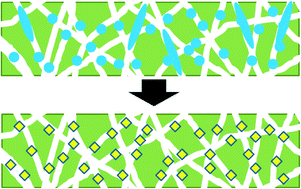Formation of organic molecular nanocrystals under soft confinement
Abstract
Methods to produce nano-sized organic molecular crystals in thin films are of great interest in the pharmaceutical industry due to the potential benefit of increased solubility of poorly soluble drugs and the advantages of film-based dosage forms over traditional tablet/capsule-based dosage forms. One method to directly form organic nanocrystals is by crystallization in confined environments where the overall crystallization volume is constrained. We report the use of a novel solution impregnation method to form nanocrystals in polymer matrices with various microstructures in order to study the structure of the confined nanocrystals and the role of soft confinement and polymer chemistry on the nucleation process of nano-sized crystals. The particle diameter correlates with the microstructure of the polymer matrices and the nucleation kinetics. In addition, by carefully choosing the experimental conditions and the polymer matrix, polymorph control of nanocrystals can be achieved. Solid-state nuclear magnetic resonance (ssNMR) was used to examine the local structure of nanocrystals inside the polymer matrices and crystal polymer interactions. This method may serve as a novel formulation method to obtain nanocrystals of poorly soluble active pharmaceutical ingredients (APIs) for pharmaceutical industry.


 Please wait while we load your content...
Please wait while we load your content...